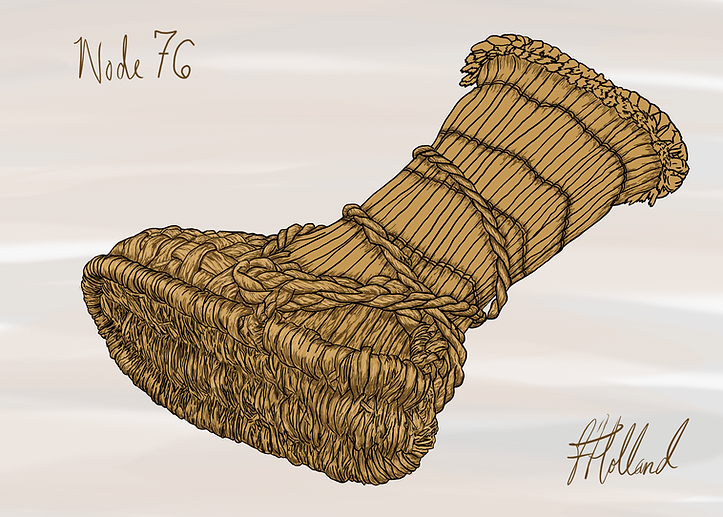
Straw Sandals Project
Data analysis and scientific illustration of unseen ancient artifacts of cultural evolution
Client: Dr. Lawrence E. Hightower, University of Connecticut, Straw Sandals Project

The Cause:
Background:
Complex human artifacts have been made by craftsmen throughout history using manufacturing knowledge and skills passed down to generations of apprentices. These manufacturing methods change over time due to migrations in populations, use of new materials native to new locations and the need to adapt to requirements of new environments, etc. In this way, technologies evolve similarly to biological evolution: subject to adaptation and selection to improve functionality.
Research Summary:
The Straw Sandals Project implements a method to analyze the evolution of techniques for making complex artifacts. This anthropological research study is led by Dr. Lawrence E. Hightower, a retired molecular and cell biology professor at the University of Connecticut; and he invented this analysis method with Dr. Barry G. Hall, evolutionary biologist and professor at the University of Rochester.
The Straw Sandals Project is “dedicated to the collection, preservation and study of plant fiber woven footwear in human migration, settlement and civilization”. The collection Dr. Hightower gathered for this project contains over one hundred pieces of woven footwear from five continents, some dating back as far as ~10,000 years ago.
This collection is now owned by the Peabody Museum of Natural History at Yale University under the name “The Lawrence Hightower Collection of Ethnographic, Ethnohistorical and Ancient Footwear”.


Straw Sandals Project Collection
Drawing the parallel between biological evolution and cultural evolution, the Hall-Hightower analysis method inputs data from each piece of the collection’s footwear into a software originally created for protein sequencing. This software creates phylogenetic trees that quantitatively and visually represent the global relationships among the specimens. These sandal construction relationships can be used in future to determine routes of ancient human migrations.
My Role:
Each piece of footwear in the collection has been cataloged and uniquely coded based on a sequence of thirty-eight different characteristics such as shoe type, tie-system and sole weaving techniques used, as well as construction material. Some individual characteristic categories contain up to nineteen recorded variations. It is this data that the phylogenetic software uses to estimate relationships between the collection’s specimens and properties of their common ancestral footwear. The resulting nodes on the phylogenetic tree represent intermediate pieces of footwear that bridge the gap of evolution between different existing pieces in the collection.
Dr. Hightower hired me during 2018 and 2019 to analyze the characteristics represented by the codes of these node ancestors and draw their most reasonable representation. This means I had to scientifically illustrate subjects that we had never seen before based on a combination of data, historical facts and my own deductive reasoning and imagination. Please see the figures below for some examples.
The Straw Sandals Project intends to “‘weave’ the strands of science, art, geography and history together that [otherwise exist] mostly as isolated threads”. It is that shared value system that made me feel so at home working on this project and regularly meeting with Dr. Hightower and his colleague, Helen Neumann.

I did all of my illustrations for this project digitally using my Wacom drawing tablet and Adobe Photoshop. I chose this medium because it is conducive to iteration, so I could edit my images based upon feedback from Dr. Hightower and updates in research results as analysis techniques progressed.
Figure 1 – Cropped annotated phylogenetic tree created from analysis of footwear from far east China & Japan
The Process:


Figure 2A – Two boots from Japan
Figure 2B – Comparison of the thirty-eight character codes for the two boots in Figure 2A to their common ancestor boot, Node 76 (all highlighted in yellow on Figure 1).

Figure 2C (right) – Progress image of my digital illustration of Node 76. I first focused on incorporating the tie system of JpK12 and the upper edge finishing technique of JpK11 into this combination of Node 76, as those were the major characteristic differences highlighted in Figure 2B.

Figure 2D – More finalized image of the Node 76 illustration with detailed shading on the sole and toe weaving patterns:

Figure 3A – Sandal from South China (SCn6 on Figure 1).
These women's straw sandals were found in a Wuxi suburb and date back to the1920s. The toe box knotting is the most intricate found to date.

Figure 3B – Digital illustration draft of Node 96, combining the sole and toe weaving pattern from Node 76 with some of the tie system of SCn6 (all highlighted in blue on Figure 1).

Figure 4A - Closeup of phylogenetic tree comparing sandals woven by the Miao people from South China

Figure 4B - Miao sandal from South China (SCn11 on Figure 4A). These handmade sandals were found in Hangzhou, Zhejiang Province.

Figure 4C - Miao sandal from South China (SCn9 on Figure 4A). These sandals were made in Guizhou Province. They are made from straw and have a black cloth strip woven into the toe.

Figure 4D - Digital illustration of Node 8 from Figure 4A. This hypothetical ancestor combines the ties of SCn11 with the sole of SCn9.



Figures 5A and 5B - Process images from scientific illustrations combining woven shoes NIn5 and NIn7 from the Kathmandu region in Nepal.


